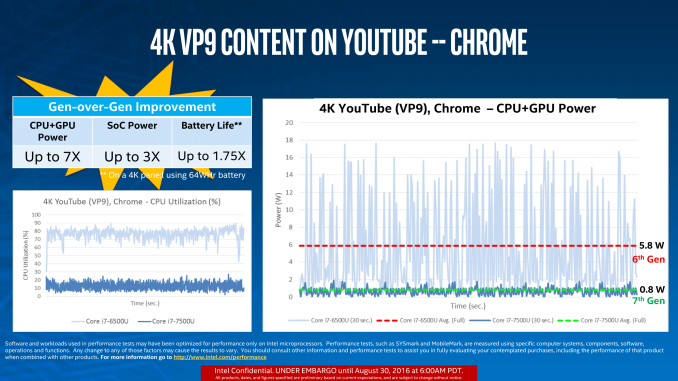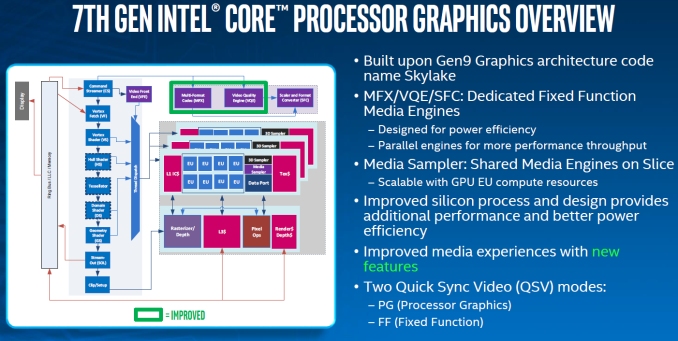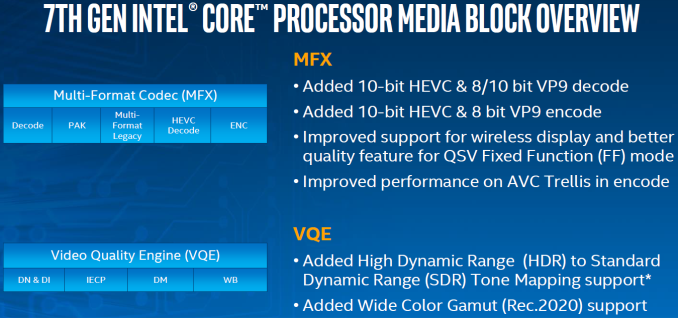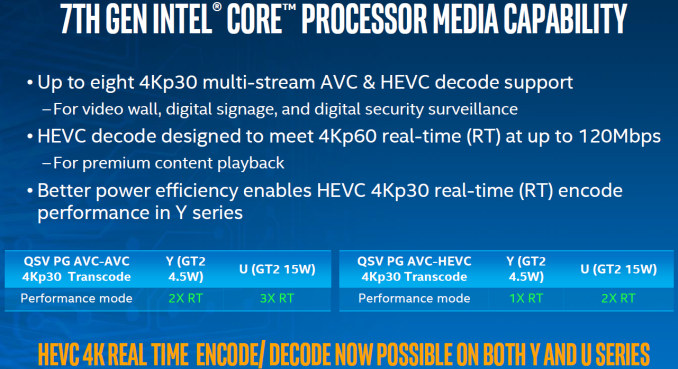Intel Announces 7th Gen Kaby Lake: 14nm PLUS, Six Notebook SKUs, Desktop coming in January
by Ganesh T S & Ian Cutress on August 30, 2016 9:00 AM EST- Posted in
- CPUs
- Intel
- 14nm
- Kaby Lake
- Gen 9
- Speed Shift
- Turbo Boost
The Kaby Lake-U/Y GPU - Media Capabilities
While from a feature standpoint Kaby Lake is not a massive shift from Skylake, when it comes to GPU matters it none the less brings across some improvements that are directly visible to the end-user. As with the CPU cores, Intel’s 14nm+ process will allow for higher GPU frequencies and overall better GPU performance, but arguably the more impressive change with Kaby Lake is the updated media capabilities. To be clear, Kaby Lake is still an Intel Gen9 GPU – the core GPU architecture has not changed – but Intel has revised the video processing blocks to add further functionality and improve their performance for Kaby Lake.
The media capabilities of the Skylake GPU was analyzed in great detail in our 2015 IDF coverage. The updates to Kaby Lake-U/Y should be analyzed while keeping those features in mind. The major feature change in the Kaby Lake-U/Y media engine is the availability of full hardware acceleration for encode and decode of 4K HEVC Main10 profile videos. This is in contrast to Skylake, which can support HEVC Main10 decode up to 4Kp30, but does so using a “hybrid” process that spreads out the workload over the CPU, the GPU’s media processors, and the GPU’s shader cores. As a result, not only can Kaby Lake process more HEVC profiles in fixed function hardware than before, but it can do so at a fraction of the power and with much better throughput.
Also along these lines, Kaby Lake has implemented full fixed function 8-bit encode and 8/10-bit decode support for Google’s VP9 codec. Skylake offered hybrid decode support for the codec, which is useful from a feature standpoint, but is a bit more problematic in real-world use since it’s not as power-efficient to use VP9 a codec implemented in fixed function hardware. Google has proven eager to serve up VP9 to its YouTube users, so they can now much more efficiently decode the codec. Meanwhile, on the encode side, brand-new to Kaby Lake is VP9 encoding support, to go with the aforementioned HEVC encode support.
| Intel Video Codec Support | |||||
| Kaby Lake | Skylake | Broadwell | |||
| H.264 Decode | Hardware | Hardware | Hardware | ||
| HEVC Main Decode | Hardware | Hardware | Hybrid | ||
| HEVC Main10 Decode | Hardware | Hybrid | No | ||
| VP9 8-Bit Decode | Hardware | Hybrid | Hybrid | ||
| VP9 10-Bit Decode | Hardware | No | No | ||
| H.264 Encode | FF & PG-Mode | FF & PG-Mode | PG-Mode | ||
| HEVC Main Encode | FF & PG-Mode | PG-Mode | No | ||
| HEVC Main10 Encode | FF & PG-Mode | No | No | ||
| VP9 8-Bit Encode | FF & PG-Mode | No | No | ||
| VP9 10-Bit Encode | No | No | No | ||
An overview of the GPU engine in Kaby Lake-U/Y is presented in the slide below.
The new circuitry for hardware accelerating HEVC Main10 and VP9 are part of the MFX block. The MFX block can now handle 8b/10b HEVC and VP9 decode and 10b HEVC / 8b VP9 encode. The QuickSync block also gets a few updates to improve quality further, and AVC encode performance also receives a boost.
The Video Quality Engine also receives some tweaks for HDR and Wide Color Gamut (Rec.2020) support. Skylake's VQE brought in RAW image processing support with a 16-bit image pipeline for selected filters. While Intel has not discussed the exact updates that enable Rec.2020 support, we suspect that more components in the VQE can now handle higher bit-widths. Intel pointed out that the HDR capabilities involve usage of both the VQE and the EUs in the GPU. So, there is still scope for further hardware acceleration and lower power consumption in this particular use-case.
Intel claims that Kaby Lake-U/Y can handle up to eight 4Kp30 AVC and HEVC decodes simultaneously. HEVC decode support is rated at 4Kp60 up to 120 Mbps (especially helpful for premium content playback and Ultra HD Blu-ray). With Kaby Lake-U/Y's process improvements, even the 4.5W TDP Y-series processors can handle real-time HEVC 4Kp30 encode.
On the subject of premium content, in their presentation Intel rather explicitly mentioned that the improved decode capabilities were, in part, for “premium content playback.” When we pushed Intel a bit on the matter – and specifically on 4K Netflix support – they didn’t have much to say beyond the fact that to play 4K Netflix, you need certification. Based on what was said and what was not said (and what we know about the certification process) our educated guess is that the updates in Kaby Lake-U/Y include some new DRM requirements for 4K content, and 4K Netflix should hopefully be good to go with the new platform. However on that note, because of those DRM requirements and that this is being pitched as a new feature for Kaby Lake, we suspect that when 4K Netflix streaming does come to the PC platform, Skylake owners are going to be out of luck.
Update: On a related note, one of the Intel press releases that has gone out today is that Sony's 4K movie and television streaming service, ULTRA, will be coming to Kaby Lake PCs in 2017. To date the service has only been available on Sony's televisions - in part for security reasons - so this is an example of one such premium content service that's coming to Kaby Lake thanks to its stronger DRM abilities.
It must be kept in mind that all the encode / decode aspects discussed above are for 4:2:0 streams. This is definitely acceptable for consumer applications, as even Blu-ray video streams (that have plenty of bandwidth at their disposal) are encoded in 4:2:0. However, if Intel wants to use the new media engine in professional broadcast and datacenter applications, 4:2:2, and, to a much lesser extent, even 4:4:4 support might become necessary. For the purpose of the Kaby Lake-U/Y consumer platforms being introduced today, this is not an issue at all.
Moving on, like the GPU core itself, Kaby Lake-U/Y's display pipeline is the same as that of Skylake. This means the iGPU can support up to three simultaneous displays.

One of the disappointing aspects from Skylake that has still not been addressed in Kaby Lake-U/Y is the absence of a native HDMI 2.0 port with HDCP 2.2 support. Intel has been advocating the addition of an LSPCon (Level Shifter - Protocol Converter) in the DP 1.2 path. This approach has been used in multiple motherboards and even SFF PCs like the Intel Skull Canyon NUC (NUC6i7KYK) and the ASRock Beebox-S series. Hopefully, future iterations of Kaby Lake (such as the desktop and high-performance mobile parts coming in January) address this issue to simplify BOM cost for system vendors.
In summary, Kaby Lake-U/Y resolves one of the major complaints we had about Skylake's media engine: the absence of hardware-accelerated 4Kp60 HEVC Main10 decode. There are a few other improvements under the hood that enable a more satisfying multimedia experience for consumers. The software and content-delivery ecosystems have plenty of catching up to do when it comes to taking full advantage of Kaby Lake-U/Y's media capabilities.














129 Comments
View All Comments
Meteor2 - Wednesday, August 31, 2016 - link
D'oh, Apollo Lake, not Broxton.ianmills - Tuesday, August 30, 2016 - link
It is interesting that the desktop cpu will be released at the same time as zen. Maybe they think zen might be competitive and are waiting to set the final clocks once zen performance is known?CaedenV - Tuesday, August 30, 2016 - link
More likely Intel has been afraid to release anything that would put AMD out of business entirely... but at the same time they are not about to let them have a foothold on the market ever again.witeken - Tuesday, August 30, 2016 - link
Here is a more up to date graph of Intel's 14nm yield than the one shown on page 1: http://www.fudzilla.com/images/stories/2016/Januar...As you can see, Intel didn't meet its forecast of the AnandTech graph. They were quite close in H2'14, but then the yield learning slowed down considerably. In the image of AT, they forecasted parity in H1'15, but in their latest graph (mine is from november '15), they forecasted mid-2016 for yield parity compared to 22nm. My guess from what I've heard from them is that this is fairly accurate. Yields should be pretty healthy by now.
lilmoe - Tuesday, August 30, 2016 - link
Ridiculous MSRPs as usual.rahvin - Tuesday, August 30, 2016 - link
As always, but I would consider the lack of built-in USB 3.1 a stunning failure. KL was under design when the 3.1 standard was finalized. Mark my words, but this time next year every single phone tablet is going to be using Type-C. Though you can use the port without the 3.1 spec it's a stunning failure on Intel's part to not integrate it when they are a key member of the USB forum.Personally I think they are doing it because they try to push people to thunderbird but it makes their default product a failure that needs another chip to provide what will be default functionality in 12 months.
beginner99 - Wednesday, August 31, 2016 - link
USB-C and USB 3.1 are not the same thing. You can use C-connector with USB 3.0 or old connector with USB 3.1doggface - Wednesday, August 31, 2016 - link
They could have supported USB3.1, but it is a bandwidth hungry monster that takes up die space. Instead they support pcie3x4 and oems can get/pay for the extra USB3.1 chip out of their own moneys. USB-c on the other hand can be hung of pretty much anything because it is just a connector.someonesomewherelse - Thursday, September 1, 2016 - link
The only way you can expect lower prices/better chips on desktop (i3 becoming 4c/8t, i5 8c/16t, i7 12c/24t and the no gpu chip with extra cores/cache desired by pc enthusiasts (lets name it i8 and give it 18c/36t and as much extra l3 cache you can fit on it with the space gained by the removal of the gpu... you could even have i6 (14c/28t) and i4 (6c/12t) chips using the same chips with defects on some of the cores/l3 and an i2 with 3c/6t or 4c/8t but with an extremely high clock rate (5GHz+ base)), no more random removal of some instructions (K class missing some of the virtualization for example), a turbo only limited by actual heat and power, mandatory ecc, 4 channel memory (which means that the high end now gets 8 channels), extra pcie lanes, unlocked multipliers and so on) is if Zen is actually faster than AMD marketing claims.So if you are a religious person start praying....
someonesomewherelse - Thursday, September 1, 2016 - link
Obviously at the same/lower price as current i3/i5/i7 chips.